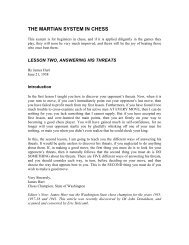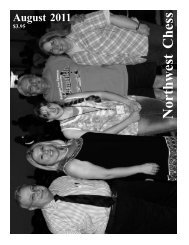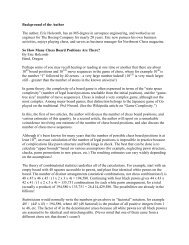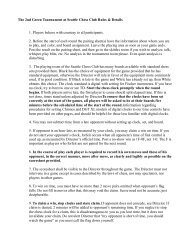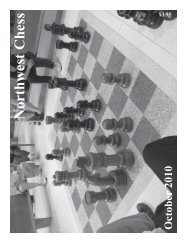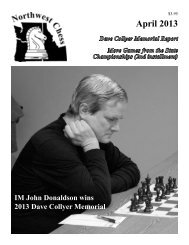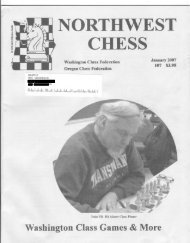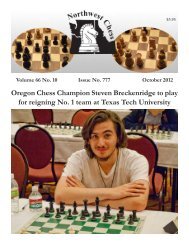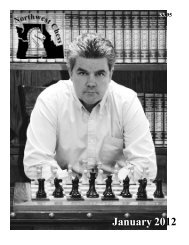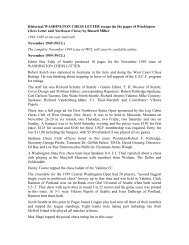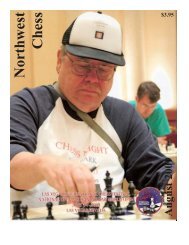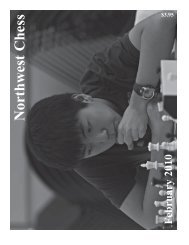April 2009
April 2009
April 2009
You also want an ePaper? Increase the reach of your titles
YUMPU automatically turns print PDFs into web optimized ePapers that Google loves.
And In The End<br />
by Dana Muller<br />
This month we look at another rook and<br />
pawn endgame. As in the March column,<br />
White has a huge, likely winning, advantage.<br />
As an aside, I’ll give a short plug for<br />
playing matches as a complement to<br />
tournament play. Being a player who entered<br />
tournaments infrequently, I found each of<br />
the three matches I played with Paul Eggers<br />
useful in shaking off the rust (computer<br />
chess was a joke in the 1980s). These short,<br />
hard-fought matches served as excellent<br />
preparation for future tournaments.<br />
Dana Muller – Paul Eggers<br />
Match<br />
July 1980<br />
From Black’s perspective, there is an<br />
immediate decision whether to play actively<br />
or passively. Since immediate active play<br />
seems to result in the loss of the h6-pawn, I<br />
think Black made the right choice.<br />
The other headache Black has to deal<br />
with is the where to place the queenside<br />
pawns. They are potential targets for a rook<br />
on the seventh rank, but advancing any one<br />
of them has drawbacks. Moving the c-pawn<br />
to c5 soon requires b6 as support; this allows<br />
the white king an easy road to the queenside.<br />
Moving a pawn to a6 or a5 leaves a hole at<br />
b6, and it may be possible for white to fix<br />
the weakness with c3-c4-c5.<br />
32. h4 Kf6 33. Rd4 Re7<br />
Beginning to maneuver the white rook<br />
and king; Black can’t allow the exchange<br />
of rooks<br />
34. Rd6+ Kg7<br />
Black needs to defend the h-pawn.<br />
35. Kf4<br />
37. Rh7! (a useful finesse) 37. ...Kg6 38.<br />
Rxb7 Rf2+ (forcing a temporary retreat) 39.<br />
Kg3 Rxc2 40. h5+ Kf6 (40. ...Kg5 41. Rg7+<br />
Kf6 42. Rg6+ gives White an extra tempo)<br />
White’s edge is clear: a pawn ahead and<br />
more active rook. That there are pawns on<br />
both sides of board is what gives White a<br />
probable win. If you removed all six<br />
queenside pawns, the position would be a<br />
draw. With that in mind, White should try<br />
to limit pawn exchanges as much as<br />
possible.<br />
Looking at the big picture, white plans<br />
to first fix the kingside with h3-h4-h5, and<br />
if allowed, to fix the queenside with moves<br />
such as a2-a4, c3-c4-c5. Complementing the<br />
pawn moves will be rook and king<br />
maneuvers looking to infiltrate the black<br />
position. The initial part of this grand<br />
strategy will be fixing the black pawn as a<br />
weakness on h6. Black will need to defend<br />
the h6-pawn: if the pawn falls White will<br />
have connected passed pawns which should<br />
be decisive.<br />
35. ...a6<br />
Black decides to defend passively (at<br />
least for the time being).<br />
The active 35. ...Re2 deserves<br />
consideration. This move is Black’s best<br />
chance to making active play work, since<br />
White is less advanced at this point (i.e.<br />
white hasn’t fixed the pawn structure). 35.<br />
...Re2 36. Rd7+ Kf6 (on 36. ...Kg8 [or Kf8,<br />
Kh8] 37. Kf5 idea 38. Kg6 with both mate<br />
threats and attacking the h-pawn looks very<br />
bad for black.)<br />
41. Rh7 (h-pawn!) 41. ...Rxc3+ 42. Kh4<br />
Rc2 43. Rxh6+ Kg7 44. Rd6.<br />
<strong>April</strong> <strong>2009</strong> Northwest Chess Page 27



